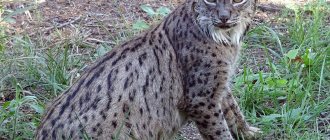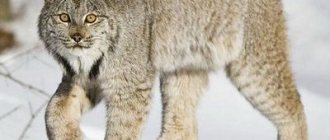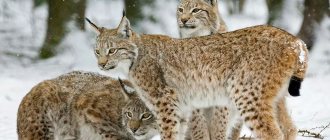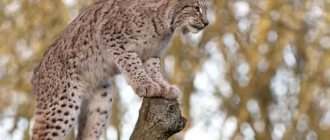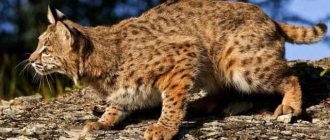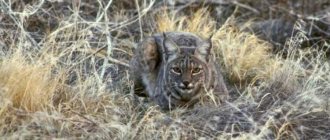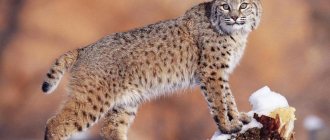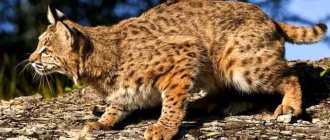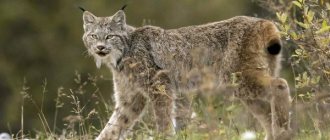Why is it called that?
It is generally accepted that the etymology of the word “lynx” is inextricably linked with the color of the animal, since its meaning in languages related to Russian is translated as “red”, “red”. However, the roots of the name go much deeper, from the common Slavic rysь to the Indo-European leuk, which means “to glow”, “to burn”. As a result, it turns out that the lynx was named so because of its burning eyes, capable of glowing in the dark.
It is interesting that the ancient Greeks considered the lynx almost a mystical animal. They believed that she could see through objects, at any time of the day and from any angle. In 1960, even a constellation was named after the predator, and its discoverer, Polish astronomer Jan Hevelius, explained his act this way: “In this part of the sky, the stars are so small that only a lynx’s eyes can see and recognize them.”
general description
The first association that arises when hearing the word “lynx” is fluffy spotted fur, tassels on large protruding ears and a short, as if chopped off, tail. Indeed, all of the listed characteristics are characteristic of this predator, which is widespread throughout Eurasia and North America. Although, depending on the species and geographic location of a particular population, the appearance of the animal may differ.
For example, the common lynx (Lynx lynx), the largest representative of the breed, has a body length of up to 130 cm (excluding the tail) and weighs up to 35 kg. And the smallest red lynx (Lynx rufus) boasts a maximum body length of only 100-105 cm and a weight of up to 18-20 kg. Males are much larger than females, have a more powerful muscle corset and physical endurance.
The animal’s head is short and wide, the nose protrudes slightly forward in relation to the muzzle, the eyes are oval, resembling yellow oval plums with black “bones”-pupils in the middle. On the pointed tips of the ears there are black antennae 4-5 cm high.
Like all predators, the lynx has powerful jaws and a number of strong, sharp teeth. Adults have a total of 30 teeth; the lateral fangs are especially dangerous. A characteristic beard or sideburns “grows” on the muzzle - coarse hair hanging down in neat clusters.
The beast has a muscular, rather short body, as well as long, developed limbs. It is not surprising, because he has to run a lot, tracking down prey or patrolling the perimeter of his territory. The front paws are always shorter than the hind paws; in winter, they are densely overgrown with hair, which helps them move better in deep snow. Like cats, lynxes are also digigrade walkers, so their sharp claws tend to retract into the pads of their toes, providing a silent gait. When a lynx walks at a walk, it places its hind paws exactly in the footprint of its front paws. The footprints can be identified by a slightly round imprint, slightly rounded at the front.
The animal's tail has an unfinished appearance, chopped off somewhere in the middle. Although this is exactly what nature intended, giving it a length of 5-30 cm (depending on the species of the breed). The coat color can vary from rusty red to smoky gray with pronounced spotting on the paws, neck and sides. In the lower part of the body the pile is longer, but not too thick. In spring and autumn, animals actively shed, and by winter they acquire a new beautiful fur coat.
Lynxes are not only excellent runners, but also skilled swimmers. They love water, are not afraid to make long swims and are excellent at navigating the terrain. Due to the anatomical features of the structure of the speech apparatus, “big cats” are not able to growl loudly, but can only hiss, meow and make high-pitched sounds, which are sometimes compared to a bear’s roar. Also, predators should not take away from their visual and hearing acuity. But their sense of smell is not as good as with other senses. An interesting fact is that if a lynx is deprived of its ear tufts, it will lose almost half of its hearing.
Habitat
Lynx can be found in the forests of Eurasia and North America. Occasionally, the predator is observed even in the Arctic Circle, but this is only in exceptional cases. The greatest likelihood of encountering a wild cat is in the countries of Scandinavia, the Baltic countries, Hungary, Slovenia, Croatia, as well as China, Mongolia, Azerbaijan, and Kazakhstan.
The reason for the decrease in the lynx population is systematic deforestation, as well as hunting for valuable lynx fur. Despite the fact that the animal once inhabited almost the entire territory of Central and Western Europe, by the end of the 20th century it was mercilessly exterminated in many European countries. In some of them, the lynx was reintroduced and reproduces quite successfully today.
On the American continent, the habitat of the predator runs from southern Canada all the way to Mexico. But the largest concentration is in the southeastern United States. The animal has taken root well in Kamchatka, having mastered this territory at the beginning of the 20th century.
The lynx feels most comfortable in hard-to-reach coniferous and deciduous forests with thickets of young animals, where you can easily set up your den. If we talk about the Eurasian zone, then the favorite habitat is the taiga, less often the forest-tundra and other areas characterized by low-growing vegetation. The animal will never settle in an open area, but when a place has been chosen, it will not change it unless absolutely necessary.
Lynx at home
The caracal is a domestic lynx, characterized by excessive energy and a pronounced hunting character. Initially, the predator was tamed for hunting game; the ownership of this animal began to be a sign of wealth.
The habitat of wild caracals is Africa and Asia. The caracal is smaller in size than the common lynx. The short coat is sandy in color with dark ears. The weight does not exceed 25 kilograms, and the height is 50 centimeters. The predator feeds on meat and eats up to one and a half kilograms per day.
Caracals are ready to breed when they reach one year of age. The mating season lasts from early autumn to early winter. This is mainly due to the animal having excess food at this time of year. Pregnancy lasts for 2-4 months. Usually 2 to 7 lynx cubs are born. By six months, kittens begin to live independently.
Caracals have strong natural immunity and rarely get sick. Such predatory cats live for about fifteen years.
Lifestyle
The wild cat is nocturnal, preferring to lie down in secluded places during the day and go out hunting at nightfall. Interestingly, she jumps to the place of the “partisan” shelter to hide any traces of her presence. This could be a crevice in the rock, a thicket of forest, a badger hole, or just a large hole, the size of which allows you to fit the whole thing in it. Despite the apparent lazy doze, the predator instantly records any movements around and is always on the alert.
Under the cover of darkness, hunting time begins. The victim is either waited in ambush or grabbed in a pounce. The lynx approaches her on the sly, makes several sharp jumps and quickly attacks, giving no chance of salvation. If the prey was not caught the first time, then it can be pursued for about 50-80 meters, and then, if unsuccessful, released in all four directions. The predator does not waste energy, preferring to switch to other trophies. Contrary to popular belief that a lynx can attack prey directly from a tree, in reality this does not happen. From above, they only look out for suitable locations for hunting, and the actions themselves take place exclusively on the ground.
An experienced predator tries not to make unnecessary tracks when walking along old trodden paths. He becomes especially vigilant in winter, when the slightest disruptions in “walking” are visible in the snow. So that the prey does not suspect anything, the lynx always sneaks up on it from the leeward side. The trophy list can include any animal that is unlucky enough to come into view, from small rodents to roe deer and wild boars. If possible, the diet includes poultry, sheep, goats, if there is human habitation in the access area. Sometimes even fish and snakes can be caught.
To get enough, a wild cat needs on average 2-3 kg of meat per day, and when completely hungry, it can eat all 5-6 kg. Uneaten food is hidden in stashes, but always so ineptly that it is not difficult for other predators to detect it. That is why wolverines and foxes often follow the tracks of lynxes, and they do not mind feasting on other people’s hunting trophies. The former behave very boldly and even allow themselves to drive away the lynx, while the latter, on the contrary, can easily pay with their lives for their bold behavior. The lynx never touches killed foxes, since its aggressiveness only works in the context of the struggle for food competition.
Animals lead a predominantly solitary lifestyle, forming pairs only during the breeding season. Females stay with the brood, teaching the cubs the wisdom of survival in the wild. As a rule, the personal possessions of adult individuals range from 80 to 250 square meters. km. The tour of the territory lasts for 5-10 days.
All types of lynx
There are several subspecies of lynx:
- Ordinary. The most common subspecies of lynx.
- Canadian. Mainly distributed in Canada. The fur is grayish-brown. Half the size of the common lynx.
- Pyrenean. Habitat: southwest Spain. The rarest subspecies living in the wild. It is listed in the Red Book and is the rarest mammal on earth. The fur is light in color and has bright spots.
- Redhead. Habitat: United States of America. The fur is red with a gray tint, but there are individuals that are completely black - melanistic. It is seriously inferior in size to the common lynx and weighs only 6-11 kilograms.
Reproduction
Females reach sexual maturity by 1 year of life or 1 year 9 months, males a little later - from one and a half years to 2 years 9 months. The mating season begins in February and usually lasts until the end of March. At this time, the female becomes the subject of fights by the males, who become like angry “rams.” They constantly fight with each other, clashing heads, walk after the object of their desire and wait to see which of them will be chosen for mating. This entire “concert” is accompanied by growling sounds, low-pitched meows, guttural screams and other attention-grabbing gestures.
When a couple is created, the newly-made family stays together for some period. Pregnancy in females lasts 2-2.5 months, and birth occurs in May-June. A few hours before contractions, the lynx begins to look for shelter in order to reproduce its offspring. As a rule, these are earthen pits under trees that have fallen to the ground, holes or hollows of other animals, and mountain crevices. The bottom of the den is covered with soft wool bedding. On average, a litter consists of 2-3 cubs, but 5-6 lynx cubs can appear at once.
Newborn babies weigh about 250-300 g, completely deaf, blind and helpless. The eyes open only on the 12-14th day of life. After about a month, solid food appears in the diet of lynx cubs, and starting from 2 months, the female brings meat prey.
The educational process of hunting takes place on small rodents and hares; the mother brings them alive and clearly shows the younger generation what to do. At 3 months of age, the cubs already follow their mother, getting out of the house, and after 5 months they begin to hunt independently. Final separation occurs approximately one year after birth. The female begins to prepare for new offspring, so she loses interest in older children.
Males do not take any part in raising the cubs, entrusting this mission to the female half. After mating, pairs usually separate. In the wild, bobcats can live up to 25 years, but the average age range is around 15-20 years.
Other interesting facts about lynx
What else can you tell about interesting things from the life of this beautiful, but dangerous and wayward animal? For example, these facts:
- Domestic lynx is the result of modern selection. By crossing a domestic cat and a Canadian lynx, a new breed was developed, which has taken root well among lovers of non-standard animals. When getting such a pet at home, you need to be prepared that it will never become completely tame. Moreover, it is not recommended to keep it in apartment conditions - for a comfortable life, a lynx needs a spacious enclosure in which it can move and develop freely. Also, a wayward cat quickly gets used to people, so it requires constant attention from its owners.
- You won’t find lynx meat in restaurants today, and it seems strange that you can cook any dishes from it. Meanwhile, a few centuries ago in many European countries, serving lynx meat was considered absolutely normal. In Rus', they cooked it into a roast and treated it to the royals; in Rome, it was stewed in wine, and at Viking feasts, game was a must.
- The spotted color helps predators camouflage among the trees. In the sun, textured spots reflect from the ground, making the animals visually invisible.
- The lynx is too smart to attack a person. An exception may be cases when a female protects her cubs or defends herself from hunters. In nature, the animal performs a sanitary function, regulating the number of individual animals and ridding the forest of weak and sick individuals.
- There are only a few cases recorded in history when domestic cats fed lynx cubs. One of them happened at the seaside zoo in 2022, and the heroine of the news chronicle was a cat named Monica. She became a foster mother for a newborn lynx cub found abandoned in the forest.
- The lynx shows care and love towards its relatives in an unconventional way, starting to lick their fur.
- The lynx has the status of the national animal of Romania and North Macedonia. It is also not without foundation that the Finnish flag depicts a lynx, not a lion.
5 / 5 ( 1 voice )
Enemies of the lynx in the wild
Despite the small commercial value of the lynx, only fur is used; the main enemy of the predator is humans. In addition to humans, in nature, the enemies of the lynx are wolves, which are characterized by pack hunting and relatives who want to occupy the developed territory or kill kittens.
A single cat tries to avoid the territories where wolves live, since entering into battle with a pack means dooming oneself to death in advance.
Regarding its relatives, the lynx marks its boundaries, and if they are violated, it can scare away uninvited guests with a hiss or engage in a fight.
